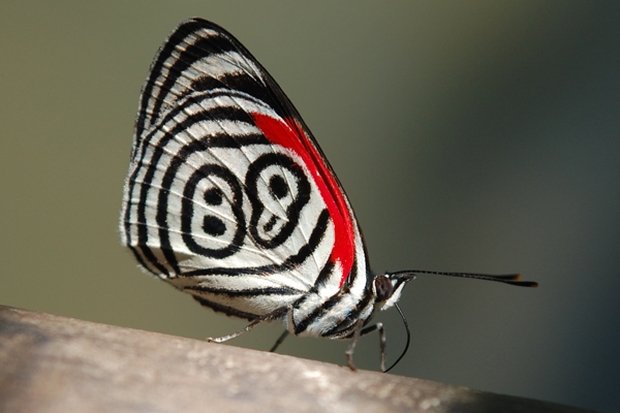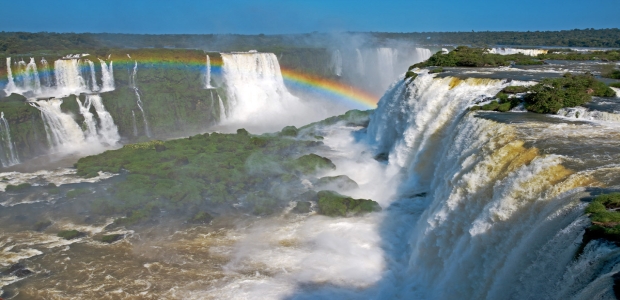Cutting a swathe through dense, emerald rain forest, the Iguazu River eventually cascades into a yawning chasm in Brazil’s Parana plateau. Few sights in the world can match this overwhelming display of nature’s raw power. The corner of Brazil that borders Argentina is the setting for a spectacular series of waterfalls that together are almost four times as wide as Niagara Falls and 100 ft (30m) higher.
In a thunderous sweep almost 2 miles (3km) wide, the Iguazu Falls tumble over the rim of the Parana Plateau and plunge into a gorge, aptly named La Garganta del Diablo, the Devil’s Throat, 260ft (80m) below. A frothy white torrent of mist and spray rises from the rocky jaws of the gorge, rainbows arch over and through one another, and the perpetual sound of roaring water can be heard 15 miles (24km) away.

On visiting this spectacular site, Eleanor Roosevelt, the wife of US President Franklin d. Roosevelt, remarked, “It makes our Niagara Falls look like a kitchen faucet.” And the Swiss botanist Robert Chodat (1865-1934) described the falls’ imposing grandeur thus, “When we stand at the foot of this world of cascades and, raising our eyes, see 269 feet above us the horizon filled with a line of waters, this awesome spectacle of an ocean pouring into an abyss is almost frightening.”
Around 275 individual waterfalls, divided by rocky, tree-covered islands, make up Iguazu’s mighty cascade. The plateau over which the waterfalls flow is formed of solidified lava and tough volcanic rocks such as basalt. These rocks are not easily eroded and resist the rushing water, forcing it to flow into narrow channels around them – hence the formation of numerous rocky islands. Some falls plunge from rim to gorge in one continuous spill, others splash from ledge to ledge before reaching the bottom. At the base of the gorge the falls merge with turbulent rapids and flow on swiftly to join the Parana River about 14 miles (22.5km) farther south.
Only two South American rivers, the Amazon and the Orinoco, are mightier than the Iguazu River, which feeds the falls and is 1500-3000ft (450-900m) wide for much of its length. The river’s rise and fall – and thus the volume of water toppling over the falls – depends on the seasonal rainfall that collects in its drainage basin. At the height of the rainy season, from December to February, the swollen river hurls almost 3 million gallons (13.6 million litres) of water per second down the Devil’s Throat – enough to fill six Olympic-size swimming pools. In the dry season, from April to October, the flow reduces considerably, with only 500,000 gallons (2.3 million litres) of water spilling over the cliff each second. And every 40 years or so, an excessively severe dry season causes the river to dry up completely. When this last occurred, in 1978, the falls were reduced to no more than a line of rocky cliffs and remained that way for a month, until a trickle of water appeared – a sign that they were about to come back to life.
Iguazu means ‘great water’ in Guarani, the language of the Indians who originally inhabited this watery paradise, rich in lush tropical vegetation. According to Guarani legend, the origin of the falls can be traced to the vengeful action of the god of waterways, a serpent who lived in the Iguazu River. When a beautiful maiden, Naipi, was to be sacrificed to the god, a warrior named Taroba rescued her and the pair eloped downriver in a canoe. The god was furious and, to prevent the lovers from travelling too far, he slithered deep under the river, shattering the earth and splitting its surface into a line of waterfalls.
The Indians lived here long before the Spanish explorer Alvar Nunez Cabeza de Vaca ‘discovered’ the Iguazu Falls in 1542 while keading an expedition of 280 soldiers from the coast of Brazil to the newly founded city of Asuncion in Paraguay. In line with contemporary custom, Cabeza de Vaca named the falls Saltos de Santa Maria after the Blessed Virgin Mary, but they quickly reverted to their local Gurani name. Cabeza de Vaca’s discovery left him curiously unmoved. The first account of the expedition, published in Spanish in 1555, merely mentions that “the current of the Iguazu was so strong that the canoes were carried violently downriver, because close to that point is a large fall….It was therefore necessary to take the canoes out of the water and carry them on land past the waterfall.”
The botanist Robert Chodat was clearly very impressed, however. He was enthralled by the region’s thriving plant life, which he recorded as, “an exuberant, almost tropical vegetation, the fronds of great ferns, the shafts of bamboos, the graceful trunks of palm trees, and a thousand species of trees, their crowns bending over the gulf adorned with mosses, pink begonias, golden orchids, brilliant bromeliads and lianas with trumpet flowers….”
In the 1930’s, Brazil and Argentina established national parks on their respective sides of the falls to protect the area’s rich tropical and subtropical wildlife. Birds such as tinamous and parrots haunt the trees, and swift nest in the craggy outcrops of the falls, swooping low over the river to feed on the swarms of insects that hover there. These include hundreds of species of butterfly, some with wings the size of a human hand. The lush vegetation also supports a number of large mammals. Such as endangered ocelots and jaguars, tapirs, three species of deer and two species of peccary, an animal related to the hippopotamus family.

The graceful jaguar, the largest cat in South America, is perfectly adapted to life around the falls, using its thick, powerful limbs not only to climb trees but also to swim across rivers. It preys on animals such as peccaries and capybara, and also eats fish, deer, otters, turtles and ground-dwelling birds.

The forest-dwelling Brazilian tapir is a frequent visitor to the waters around the Iguazu Falls. A confident swimmer and agile diver, this stocky, short-legged creature is also sure-footed on land, no matter how rugged the terrain. The tapir feeds by night on leaves, buds, fruit and aquatic plants which it roots out with its long snout.

The cliffs beneath the falls are host to a number of aquatic herbs, resembling mosses and lichens that grow only in fast-flowing water. The flowers of these plants have no petals and bloom at the end of the rainy season. None is taller than 4in (10cm). For observers on the Brazilian shore the entire sweep of the falls is in clear view, while from the Argentine side visitors can climb freely through and under the waterfalls and witness their splendor close up. The grandeur and primitive beauty of the magnificent cascades together create an astonishing spectacle of nature untamed.
-end-



































